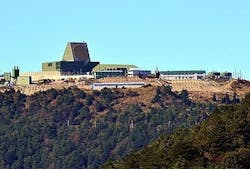Raytheon to upgrade Taiwan missile-defense surveillance radar to mitigate obsolescence issues
HANSCOM AIR FORCE BASE, Mass., 30 Nov. 2016. Missile defense experts at the Raytheon Co. will upgrade a long-range surveillanceradar system in Taiwan, which has been in operation since early 2013 to help warn the island country of attacks from neighboring mainland China.
Officials of the U.S. Air Force Life Cycle Management Center at Hanscom Air Force Base, Mass., announced a $26.2 million contract Monday to the Raytheon Integrated Defense Systems segment in Woburn, Mass., to upgrade the Taiwan Early Warning Radar Surveillance Radar system atop Le Shan Mountain, Taiwan.
Raytheon will upgrade the Taiwan missile warning system to address obsolescence concerns. The Taiwan early-warning radar is a surplus U.S. Raytheon AN/FPS-115 PAVE Phased Array Warning System (PAVE PAWS) radar sold to Taiwan in 2000 and activated in 2013.
Raytheon developed the AN/FPS-115 PAVE PAWS radar originally in the 1970s to detect and track incoming missile threats -- particularly submarine-launched ballistic missiles. Much of the 40-year-old technology in this radar is obsolescent and needs upgrading.
Related: BAE Systems to upgrade, maintain, and operate long-range missile-defense radar system
The Taiwan early warning radar system to be upgraded provides more than six minutes of warning time of surprise enemy attacks, and can detect and monitor incoming threats at distances as far as 3,100 miles. The Taiwan system has been able to monitor North Korean ballistic missile tests.
The system can detect and track ballistic missiles, cruise missiles, conventional military aircraft, and stealth fighters. Its range gives Taiwan military authorities surveillance control of aerial activities in airspace from the Korean peninsula in the north to the South China Sea in the south.
Taiwan reportedly started negotiating a deal with the U.S. to buy an advanced surveillance radar system after China fired ballistic missiles in the Taiwan Strait in 1996.
In 2012 Raytheon won a $289.5 million contract to provide sustainment support for the Taiwan early warning radar system shortly after the radar went online.
Related: Air Force asks Exelis to EMP-harden long-range ballistic missile warning radar systems
The U.S. military is upgrading the nation's network of ballistic missile early warning radars. Last May the Air Force awarded a $49.6 million contract to the BAE Systems Technology Solutions & Services segment in Rockville, Md., to maintain, upgrade, and operate the nation's Solid State Phased Array Radar Systems (SSPARS).
These radar systems -- once referred to as the Phased Array Warning System (PAVE PAWS) and the Ballistic Missile Early Warning System (BMEWS) -- is a radar, computer, and communications system for missile warning and space surveillance.
SSPARS sites are located at five separate locations: Beale Air Force Base, Calif.; Cape Cod, Air Force Station, Mass.; Clear Air Force Station, Alaska; Royal Air Force Station Fylingdales, England; and Thule Air Base, Greenland.
On contract to upgrade the Taiwan early warning radar system, Raytheon will do the work in Woburn, Mass., and should be finished by May 2018. For more information contact Raytheon Integrated Defense Systems online at www.raytheon.com, the Air Force Life Cycle Management Center at www.wpafb.af.mil/aflcmc, or the Taiwan Ministry of National Defense at www.mnd.gov.tw/English/default.aspx.
Learn more: search the Aerospace & Defense Buyer's Guide for companies, new products, press releases, and videos

